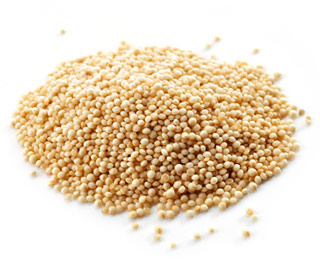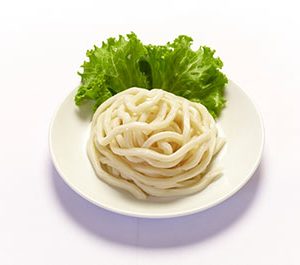The history of amaranth can be traced to ancient Mexico, where it was cultivated by the Aztecs 8,000 years ago.1 Today, it’s grown in China, Russia and throughout Eastern Europe, is still a native crop in Peru, and is emerging once again in Mexico.2
Amaranth is tall — often 5 to 7 feet3 — with broad green leaves, bright purple, red or gold flowers, and around 60 different species.4 The plant produces small seeds and is often categorized as a “grain”,5 but amaranth isn’t technically a grain like oats, wheat or rice. It’s sometimes referred to as a “pseudo-cereal” as well.6
One of the most important aspects of this tiny grain is that it’s gluten-free.7 When ground, the flour is generally white and powdery, similar to regular flour.8
Being extremely dense, amaranth is too heavy to be used by itself.9 It’s best used with other grains so that it can improve the nutritional quality without changing the taste of whatever you’re about to make.10
Cooking amaranth can be fun because of its versatility. When prepared right, it can be a healthy substitute for cereals, or a popped snack similar to popcorn. It can also be added to stews and soups or be combined with other grains to improve the product’s nutritional profile.11
Health Benefits of Amaranth
One reason amaranth is emerging into the forefront among grains is because of its remarkable nutrition. It’s rich in minerals, such as calcium, iron, phosphorus and potassium. It also has truly remarkable protein content: In just a 100-gram serving, you get 13.6 grams of protein.12
Amaranth is a great source of lysine, an important amino acid with a total of 0.747 grams per 100-gram serving.13 This is an essential nutrient that must be sourced from food, and is critical in protein synthesis.14 To support this positive aspect of amaranth, it also contains primary proteins such as methionine and leucine.15 Methionine has regulatory roles in the immune and digestive systems, as well as managing metabolic processes.16 Leucine, on the other hand, plays a role in muscle protein synthesis and “inhibit protein degradation in skeletal muscle, as well as in liver.”17
A hundred grams of raw amaranth contains 7.61 milligrams of iron, as well as 6.7 grams of fiber.18 The phosphorus in amaranth is generous as well, with 557 milligrams. Amaranth contains 159 milligrams of calcium and it’s also high in magnesium (248 milligrams) and potassium (508 milligrams). Amaranth contains healthy oils, such as unsaturated fatty acids, and omega-3, required for optimum nutrition. Not least in this list, amaranth contains 4.2 milligrams of vitamin C. For more information on amaranth, you may refer to the table below.19
| Amaranth Nutrition Facts
Serving Size: 3.5 ounces (100 grams), raw |
||
| Amt. Per Serving |
||
| Calories | 371 | |
| Calories from Fat | 0 | |
| Total Fat | 7.02 g | |
| Saturated Fat | 1.46 g | |
| Trans Fat | 0 g | |
| Cholesterol | 0 g | |
| Sodium | 4 mg | |
| Total Carbohydrates | 65.2 g | |
| Dietary Fiber | 6.7 g | |
| Sugar | 1.69 g | |
| Protein | 13.6 g | |
| Vitamin A2 IU | Vitamin C | 4.2 mg |
| Calcium159 mg | Iron | 7.61 mg |
Studies Done on Amaranth
A study on amaranth reported that not only do its seeds contain important nutritional properties, but also phytochemical compounds like rutin and nicotiflorin, and peptides with the ability to help lower hypertension and incidences of cancer.
Researchers suggested further investigation on the function of health-beneficial peptides in amaranth, particularly lunasin, which was previously identified in soybeans and thought to have cancer-preventing benefits, as well as lowering incidences of chronic diseases, such as inflammation, diabetes, heart disease and stroke.20
As cardiovascular disease (CVD) is linked to high blood cholesterol (hyperlipidemia), hypertension, obesity and diabetes, scientists reported that reducing saturated fat while increasing unsaturated fatty acids can prevent CVD. Amaranth was studied in relation to these findings and found it to be potentially beneficial for CVD patients.
Test results also concluded that amaranth oil could be a functional food product for preventing and treating cardiovascular diseases.21
Amaranth Fun Facts
In Mexico, amaranth seeds are used to create inedible food decorations. They’re formed into little skull-like confections and displayed during the Mexican “Día de Muertos” or “Day of the Dead” celebration.22
Summary
Named after the Greek word “amaranthus,” which means “unwithering,” colorful amaranth flower buds stay vibrant even after drying.23 Cultivated by the Aztecs 8,000 years ago, amaranth is still popular in many cultures, and has continued to gain recognition in recent years. It can be popped like corn, or ground to flour.
The amazing thing about amaranth is how it compares nutritionally to other grains, such as wheat. Amaranth is also a great alternative for those with gluten allergies. You’ll be able to enjoy baked products if you use amaranth in your cooking, or look for baker’s that use amaranth flour.24
Ultimately, amaranth is a true powerhouse, and may help lower the risk of numerous chronic health conditions such as diabetes,25 heart disease26 and cancer.27 Luckily, it can be found in most supermarkets. Just make sure it’s organic to help protect yourself from toxin exposure.







Reviews
There are no reviews yet.